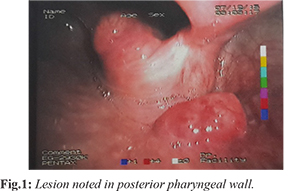6go6ckt5b8|3000F7576AC3|Tab_Articles|Fulltext|0xf1ffa4a61d0000000b01000001002300
6go6ckt5b5idvals|805
6go6ckt5b5|2000F757Tab_Articles|Fulltext
Introduction
Extramedullary plasmacytoma forms less than 10% of the overall diagnosis of malignancies related to plasma cells in a solitary manner (multiple myeloma is the commonest tumor diagnosis for this particular cell type). Whereas more than 80% of all such cases arise in the upper aero-digestive tract, only about 10% of them are laryngeal. Since the first reported EMP of the larynx in 1913 by Wachter et al. less than 100 additional cases have been described in the world literature. The subglottis and epiglottis are the most commonly involved sites within the larynx. It occurs three times more often in men than women, and is common in age group of 50-70 years. We present to you two cases of laryngeal histoplasmosis diagnosed and treated at our institute.
Case Reports
Case 1:
A 65 year old male presented with history of dysphagia and throat pain from past nine months which was also associated with sticky sensation in throat. On examination, during indirect laryngoscopy, a swelling with surface ulceration was noticed in right ary-epiglottic fold which was suspected to be malignant in nature. Biopsy following direct laryngoscopy showed plasmacytoma of the larynx. Serum proteins, erythrocyte sedimentation rate and Jones protein were within normal limits. The patient underwent endoscopic right arytenoidectomy. He refused for post-arytenoidectomy radiotherapy. Three years following surgery he again presented with throat pain and dysphagia. Upper gastro-intestinal endoscopy revealed normal larynx but small swelling was noticed in posterior pharyngeal wall and base of the tongue [Fig.1]. Endoscopic excision was done for the patient and the histopathology of the same revealed multi-centric plasmacytoma. The patient underwent radiotherapy (60 Gy) for the same. After remaining asymptomatic for few months, he presented with odynophagia. Clinically examination and PET scan showed absence of any lesion. But patient continued to have persisting complaints, thus multiple biopsies were taken from previously operated arytenoid scar, false vocal cord, post-pharyngeal wall and supraglottic region which showed evidence of residual plasmacytoma. Thus, patient was sent for chemotherapy and is still on follow up.

Case 2
A 62 year old diabetic and hypertensive patient presented to us with complaints of throat pain and change in voice since three months. His past history was insignificant. Indirect laryngoscopic examination revealed polypoidal growth on left aryepiglottic fold which was confirmed by flexible laryngoscopy [Fig.2]. Micro-laryngeal excision of the mass was done which revealed stratified squamous epithelium with sub-epithelium displaying sheets of round cells with eccentric nuclei with binucleation which suggested plasmacytoma [Fig.3]. Multiple myeloma was ruled out as all the investigations such as bone marrow aspirate, serum ß-2 microglobulin, skeletal survey, were all normal and Bence Jones protein was negative. Patient was then treated with external beam radiotherapy and has been asymptomatic since then.
Discussion
Extra-medullary plasmacytoma is an immuno-proliferative, monoclonal disease of the B-cell arising outside the bone marrow without clinical evidence of multiple myeloma. It originates as an imitation of malignant transformed plasma cells. They tend to migrate and return in the bone marrow. Rarely, they settle in soft tissue or in an extracellular connective tissue area. This is the origin for monoclonal plasma cell foci located outside the bone marrow, called extra-medullary plasmacytoma. EMP should be considered as differential diagnosis of any laryngeal mass. Prior confirmation from biopsy of the mass is mandatory to make the correct diagnosis and thus plan an accurate treatment. Radiation therapy is considered the treatment of choice for extra-medullary plasmacytoma, with local control rates of 80-100%.
The common sites of presentation of laryngeal plasmacytomas are the epiglottis, vocal cords, arytenoids and the subglottic space out of which epiglottis is the commonest. These two case reports show the importance of regular follow up, complete systemic checkups and accurate treatment after making the correct diagnosis. One case showed complete resolution but another one showed recurrence despite all measures taken.
Conclusion
In clinical practice, an otolaryngologist should always do a complete and systematic examination of the larynx when a tumor is suspected, so that a disease as rare as extra-medullary plasmacytoma can be appropriately diagnosed, thoroughly investigated and thus adequately treated.
Contributors: MBB: manuscript writing, and patient management; EM, ARB: manuscript editing, and patient management. EM will act as guarantor. All authors approved the final version of this manuscript.
Funding: None; Competing interests: None stated.
References
- Salmon SE, Cassady JR. Plasma cell neoplasms. In: DeVita VT, Hellman S, Rosenberg SA (eds.), Cancer: Principles and Practice of Oncology, 5th ed. Philadelphia: Lippincott-Raven Publishers, 1997; pp. 2344.
- Kapadia SB, Desai U, Cheng VS. Extramedullary plasmacytoma of the head and neck: A clinicopathologic study of 20 cases. Medicine 1982;61:317-329.
- Woodruff RK, Whittle JM, Malpas JS. Solitary plasmacytoma. I: Extramedullary soft tissue plasmacytoma. Cancer. 1979;43:2340-2343.
- Lewis K, Thomas R, Grace R, Moffat C, Manjaly G, Howlett DC. Extramedullary plasmacytomas of the larynx and parapharyngeal space: imaging and pathologic features. Ear, Nose and Throat Journal. 2007;86:567-569.